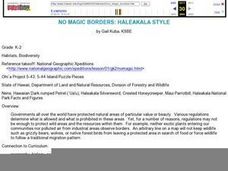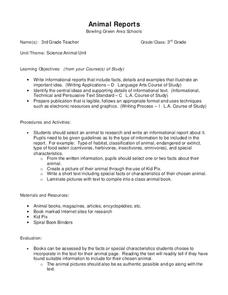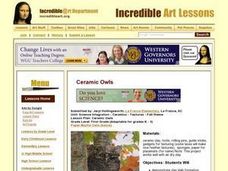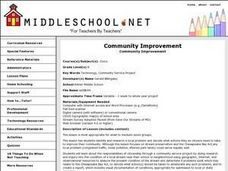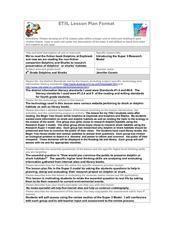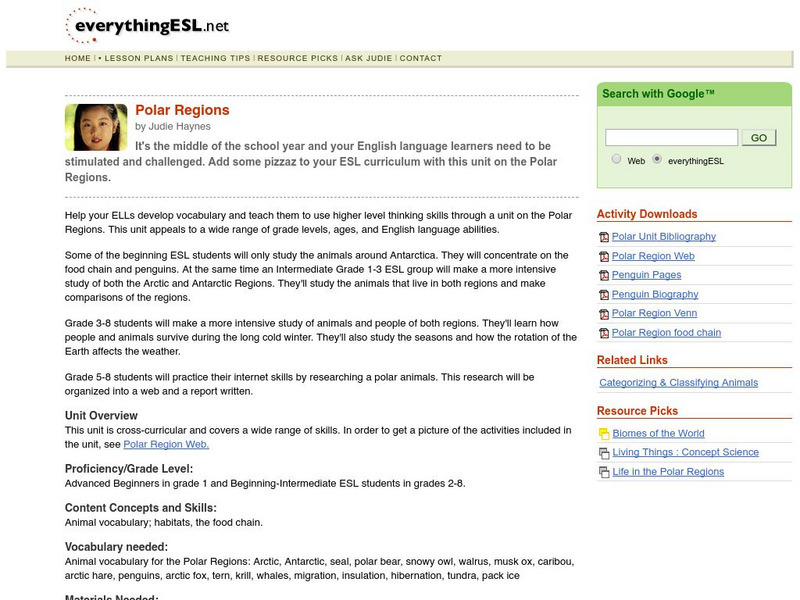Curated OER
No Magic Borders: Haleakala Style
Young scholars discuss borders and boundaries. They discuss pollution and the fact that boundaries cannot stop pollution and that pollution affects even protected wildlife and plants. They participate in an activity in which they must...
Curated OER
Animal Reports
Third graders choose an animal to research and write a report about. They determine the animals' habitat, animal classification, whether it is endangered or extinct, and the type of food it eats. Also, they add any special...
Curated OER
Force of Habitat
Students examine the Nevada state quarter and discuss the Great Basin and the desert habitat. They draw a desert animal and write a sentence about its attributes and how they help the animal to survive in its habitat.
Curated OER
Extinction
Students explore reasons why the dinosaurs became extinct, and the specific needs (habitat, environment, food) of individual types of dinosaurs.
Curated OER
Wildlife, Wolves, Endangered Species
Students use the Internet to research wildlife and conservation efforts. They examine pictures and graphics to research endangered species and humans role in their lives. They also use math to measure areas of habitats and add the number...
Polar Trec
Family Polar Fun Day
Family fun days are great for connecting home and school life, building strong parent/teacher relationships, and engaging students in a fun and social way. Here are several activity ideas to help you and your class run your own Family...
Curated OER
Ceramic Owls
Young scholars creat owls through the use of slabs of clay with pinched beak and tufts. They use a clay tool or nail to add shape to mak wings. Students use shells, and other items to create texture. After the creations have dried, young...
Curated OER
Community Improvement
Students examine a local body of water to determinet the health of its ecosystem and monitor it during the year. If needed they write a report on any conditions that need improvement including photographs and relevant data.
Curated OER
Native Plant Restoration Project
Students distinguish between exotic and native plant species. They work in groups in the field to restore a natural habitat. A class map is created to reflect their work in the field.
Curated OER
Animal Adaptations
Learners expand their knowledge of animal features and behaviors that can help or hinder their survival in a particular habitat. They participate in classroom discussions and visit a website to research animals
BBC
Ourselves
Young biologists identify parts of the body, sort humans from other animals, and list the difference they see. Learners are split up into groups of three, and each group must find pictures in magazines of humans and other animals. They...
Curated OER
Dinosaurs - Online Research
Second graders familiarize themselves with dinosaurs through online research.
Curated OER
Forests, Deserts, & Grasslands
Third graders complete activities to become familiar with the content and vocabulary related to biomes and ecosystems in order to mainstream into the classroom.
Curated OER
Pawing Around
Students identify common wildlife by investigating their footprints. They examine where and how to look for signs of animal activity. They create casts of animal tracks and gather information about the animal from the location it was found.
Alabama Learning Exchange
Flutter By, Butterfly!
Students examine the basic characteristics of butterflies. They view a butterfly PowerPoint presentation, complete various labelling activity sheets, explore websites, and design a poster that includes facts and illustrations to be used...
Curated OER
Frogs and Camouflage
Students view a variety of pictures of frogs and discuss camouflage and habitat adaptation. Students look at color, skin texture, shape, size, eyes, and surroundings as well as the need for the camouflage. Students then design a frog...
Curated OER
Reptile and Amphibian Defense Strategies
Students study the stages of the Eastern newt either by collecting a live specimen or from pictures. They note the colors of the eft stage before reading the "Eastern Newt Species Account" that shows the newt's life stages, migration,...
Curated OER
Animal: Unique Creatures With Great Features
Students present models, oral reports, and presentations on animal's characteristics. They research various animals and the characteristics that link them to specific animal groups. They answer specific questions relating to animals in...
Curated OER
Animal Adaptations
Tenth graders participate in an arthropod scavenger hunt. In groups of two, they identify and collect two specimens of arthropods in the school area, and create a table of all the specimens and what class they belong to.
Curated OER
Introducing the Super 3 Research Model
Fourth graders read the fiction selection, Dolphins at Daybreak, and then the corresponding non-fiction books about dolphins and sharks. They use a specific research model to find information about dolphins and sharks from books and...
Crayola
Crayola: Dreams and Dinosaurs (Lesson Plan)
This site is a great way to wrap up a unit on dinosaurs. Children create their own "Window clings," then use them in sorting activities. Also provides resources and adaptations. (To access this lesson plan, you must register with...
Everything ESL
Animal Habitats: The Polar Regions
Stimulate and challenge your ESL young scholars with a unit on Polar regions. Students will use higher level thinking skills while learning about animals, habitats and food chains. You will find many downloadable pages.
HotChalk
Hot Chalk: Lesson Plans Page: Penguin Theme Unit
This lesson is designed to help young students learn about penguins over a five-day unit.
Discovery Education
Discovery Education: Habitats of the World
This site has a lesson to use to start a unit on biomes and animal habitats. This plan incorporates grasslands, temperate forests, tropical rainforests, deserts, polar ice regions, and tidepools.


